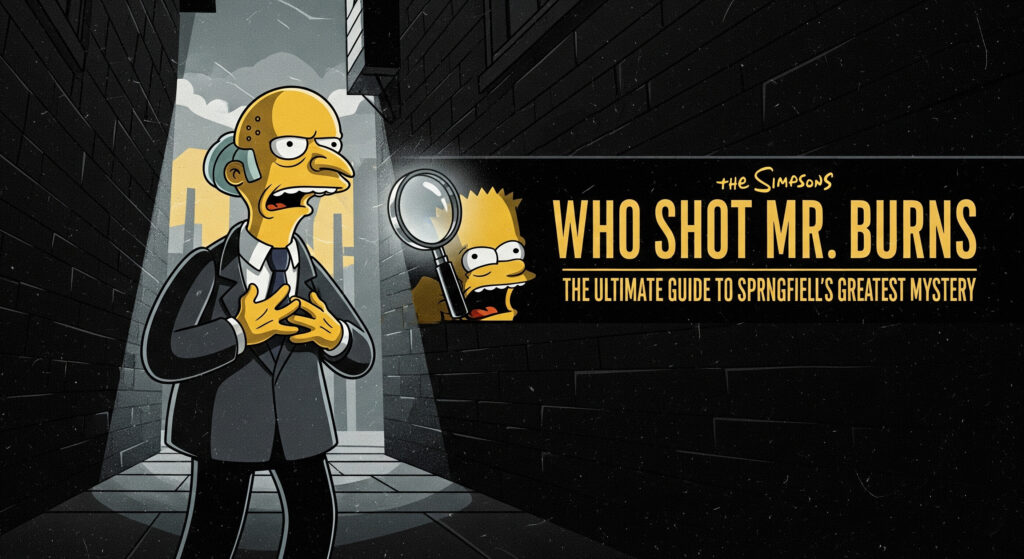Uncategorized
Who Shot Mr. Burns in The Simpsons: The Ultimate Guide to Springfield’s Greatest Mystery
One of the most iconic storylines in The Simpsons history remains the burning question that captivated audiences worldwide: who shot Mr. Burns? This legendary two-part episode arc from seasons 6 and 7 became a cultural phenomenon that transformed how television shows approached season-ending cliffhangers. The mystery gripped fans for months, spawning countless theories and turning Springfield’s most despised billionaire into the center of primetime television’s most talked-about whodunit.
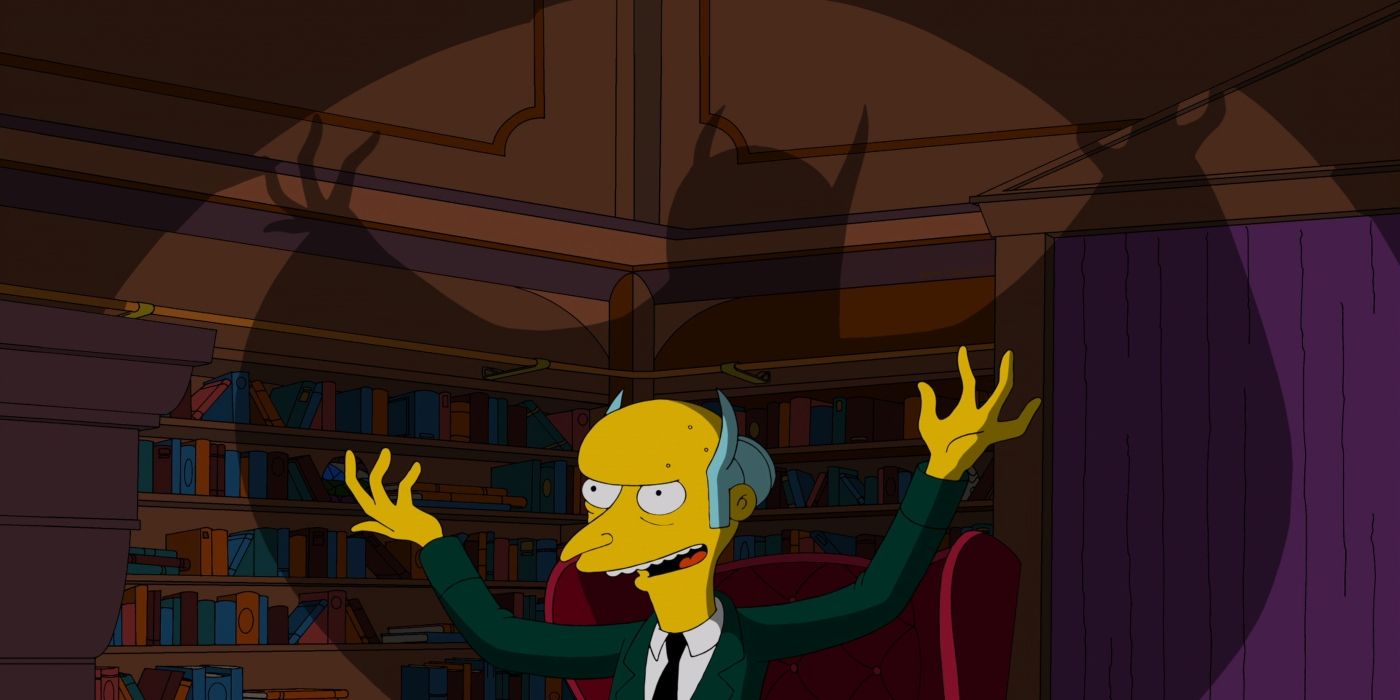
The Mr. Burns shooting mystery wasn’t just another episode it was a masterclass in storytelling that kept viewers on the edge of their seats. From the moment that gunshot rang out in the Springfield town square, fans became amateur detectives, analyzing every clue and motive. This comprehensive guide will unravel the complete story behind one of animation’s greatest mysteries, exploring every suspect, clue, and the shocking revelation that changed Springfield forever.
The Setup: “Who Shot Mr. Burns? Part One”
The mystery begins in the season 6 finale, aptly titled “Who Shot Mr. Burns? Part One.” The episode masterfully establishes multiple suspects, each with compelling motives to harm Springfield’s most villainous resident. The writers brilliantly crafted a web of grievances against Mr. Burns that made nearly every character in Springfield a potential shooter.
In this pivotal episode, Mr. Burns reaches new heights of villainy by attempting to steal oil discovered beneath Springfield Elementary School. His diabolical plan involves constructing a massive drilling operation that would not only rob the school of its newfound wealth but also block out the sun over Springfield. This environmental catastrophe would force residents to rely entirely on his nuclear power plant for energy.

The episode systematically builds tension as Burns’s actions affect various Springfield residents. Grandpa Simpson loses his retirement home when Burns forecloses on the Retirement Castle. Moe Szyslak faces financial ruin when his tavern loses customers due to Burns’s machinations. Even Barney Gumble suffers when Burns destroys his potentially lucrative business venture.
The Shooting: A Town Square Showdown
The climactic scene unfolds in Springfield’s town square during a community meeting about Burns’s latest scheme. As tensions reach a boiling point, the crowd grows increasingly agitated with their antagonist. Burns, displaying his characteristic arrogance and disregard for others, dismisses their concerns with his typical condescending attitude.
The mystery deepens when Burns approaches his luxury vehicle, struggling to remember someone’s name a detail that would prove crucial to solving the case. As he fumbles with his car door, a gunshot rings out, and Mr. Burns collapses, shot and seriously wounded. The screen fades to black with Burns’s fate uncertain, leaving viewers with the tantalizing question that would dominate pop culture discussions for months.

The shooting scene was deliberately crafted to obscure the shooter’s identity. The camera angles, lighting, and crowd positioning made it impossible for viewers to definitively identify the culprit. This masterful cinematography ensured that the mystery remained unsolved until the following season’s premiere.
Prime Suspects: Everyone Had a Motive
The beauty of the Mr. Burns shooting storyline lay in how virtually every Springfield resident had legitimate reasons to want him gone. The writers created a perfect storm of motives that made solving the case genuinely challenging for viewers trying to play detective at home.
Homer Simpson: The Obvious Choice
Homer Simpson topped most fans’ suspect lists due to his long-standing antagonistic relationship with his boss. Burns consistently forgot Homer’s name, calling him everything except his actual name, which provided both comedic relief and genuine motive for revenge. Homer’s job at the nuclear plant put him in daily contact with Burns, giving him ample opportunity to develop resentment.
Homer’s motive intensified when Burns’s oil drilling operation threatened his family’s well-being. The potential environmental damage and economic impact on Springfield directly affected the Simpson household. Additionally, Homer’s impulsive nature and history of rash decisions made him a believable candidate for the shooter.
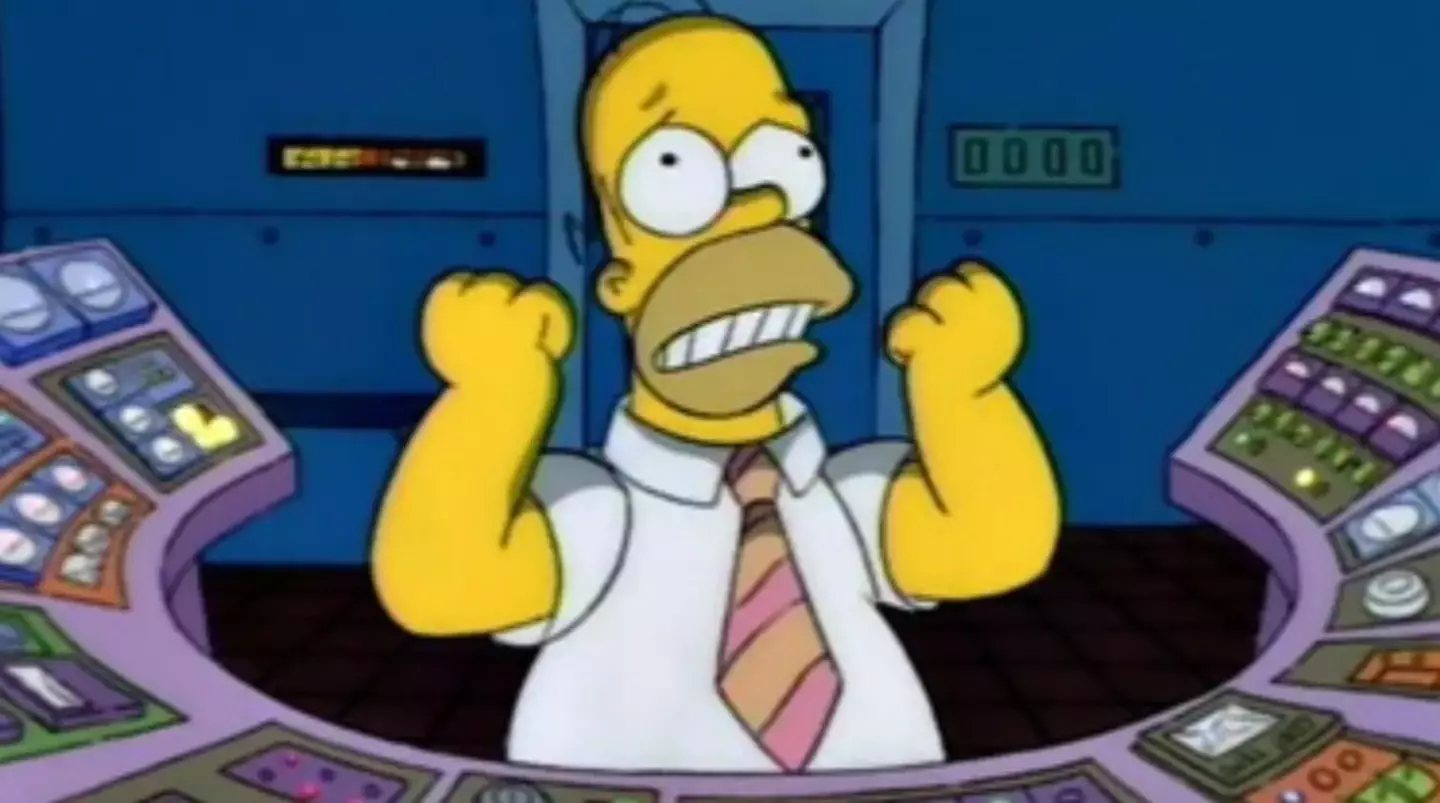
Grandpa Simpson: A Victim of Greed
Abraham “Grandpa” Simpson emerged as another compelling suspect when Burns foreclosed on the Springfield Retirement Castle. This action displaced elderly residents, including Grandpa, causing significant hardship and emotional distress. The loss of his home and community represented a devastating blow to someone in his golden years.
Grandpa’s military background and historical connection to violence made him a credible threat. His stories of wartime experiences, while often exaggerated for comedic effect, suggested familiarity with firearms. The combination of personal grievance and potential capability elevated Grandpa to serious suspect status.
Barney Gumble: Dreams Destroyed
Barney Gumble’s transformation from chronic alcoholic to aspiring filmmaker created an unexpected subplot in the mystery. His documentary project showed promise until Burns’s interference destroyed his equipment and crushed his newfound sobriety and ambition. This represented more than financial loss it symbolized the destruction of hope and personal growth.
The psychological impact of having his dreams shattered by Burns’s callousness provided Barney with powerful motivation. His return to drinking following the incident demonstrated the profound effect of Burns’s actions on his mental state and recovery journey.
Moe Szyslak: Financial Ruin
Moe’s Tavern faced closure due to Burns’s economic manipulations affecting his customer base. For Moe, his bar represented more than just a business it was his identity, social circle, and primary source of income. The threat of losing everything he’d worked for created desperate circumstances that could drive someone to extreme measures.
Moe’s rough background and connections to Springfield’s seedier elements made him a natural suspect. His familiarity with violence and questionable moral compass provided both means and opportunity for revenge against Burns.
The Big Reveal: “Who Shot Mr. Burns? Part Two”
Season 7’s premiere, “Who Shot Mr. Burns? Part Two,” finally provided the answer that fans desperately sought. The revelation proved both shocking and satisfying, as the writers delivered a solution that was simultaneously unexpected and perfectly logical within the show’s established mythology.
The investigation, led by Chief Wiggum with his characteristic incompetence, takes viewers through various false leads and red herrings. Each suspect is questioned, alibis are examined, and evidence is evaluated in typical Simpsons fashion with humor balancing the dramatic tension of the mystery’s resolution.
The Truth: Maggie Simpson
The shocking answer to who shot Mr. Burns is none other than Maggie Simpson, the family’s infant daughter. This revelation stunned audiences who had theorized about various adult suspects but never considered the baby as a potential shooter. The solution was both surprising and ingenious, fitting perfectly with The Simpsons’ tradition of subverting expectations.
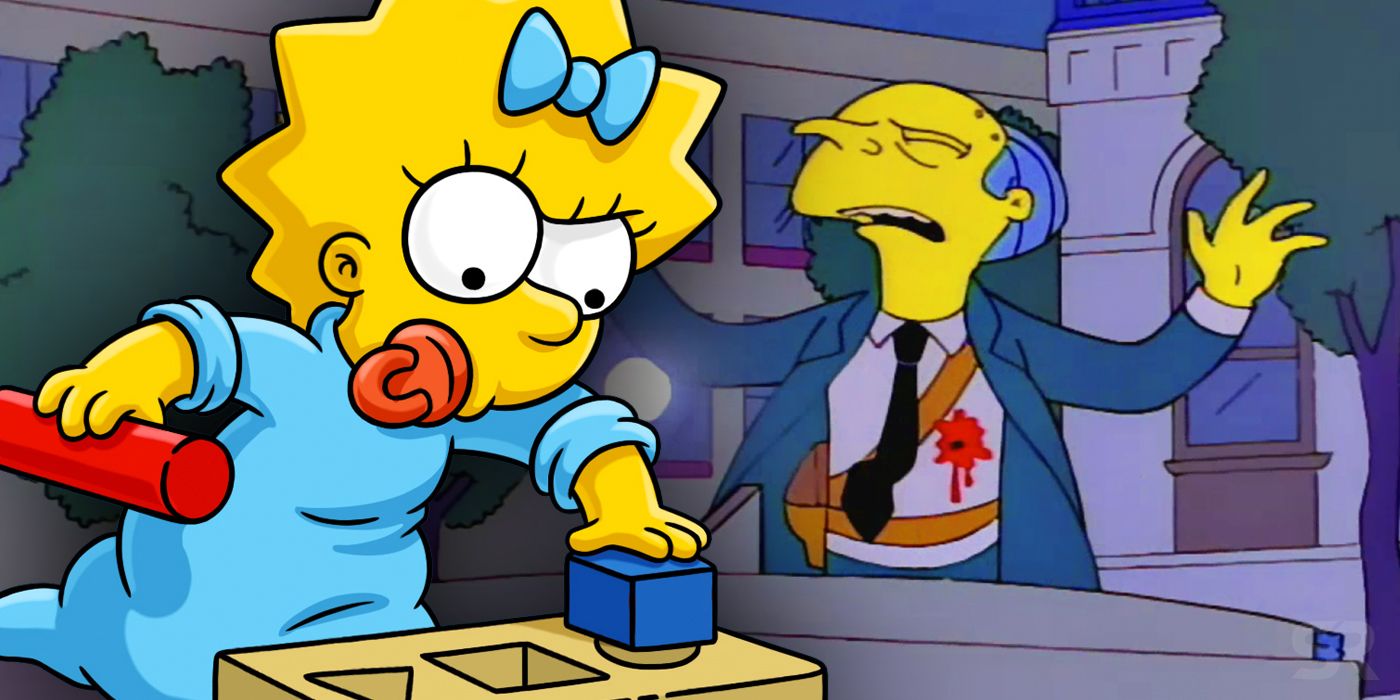
The shooting occurred when Homer Simpson brought Maggie to confront Burns at his office. During a heated argument, Burns attempted to take candy from the baby, leading to a struggle. In the ensuing chaos, Burns’s gun fell into the car where Maggie was seated. As Burns tried to retrieve the weapon, it accidentally discharged, shooting him in the chest.
The Clues Were There All Along
Rewatching the episodes reveals that the writers planted numerous clues pointing to Maggie throughout both parts of the story. The most significant hint appears in the opening credits of Part Two, where Maggie’s name appears in the cast list something that never happened in regular episodes. This subtle detail provided eagle-eyed viewers with the ultimate spoiler.
Additional clues included Burns’s struggle to remember someone’s name (he was trying to recall “Maggie”), the positioning of characters during the shooting scene, and various visual hints scattered throughout both episodes. The writers demonstrated remarkable attention to detail in crafting a mystery that was solvable for dedicated viewers willing to analyze every frame.
The Cultural Impact and Legacy
The Mr. Burns shooting mystery transcended television entertainment to become a genuine cultural phenomenon. The storyline demonstrated The Simpsons’ ability to generate mainstream media attention and water cooler conversations across America. News outlets covered fan theories, celebrities weighed in with their guesses, and the mystery became a shared national experience.
This two-part episode arc established a template for television cliffhangers that influenced countless shows across various genres. The success proved that animated series could generate the same level of audience investment and emotional engagement as live-action dramas. The mystery’s impact extended far beyond The Simpsons, influencing how television writers approached season-ending storylines.

The storyline also showcased the writers’ sophisticated understanding of mystery genre conventions. By subverting traditional whodunit expectations while honoring the format’s essential elements, they created something uniquely entertaining that satisfied both casual viewers and mystery aficionados.
Behind the Scenes: Creating Television History
The development of the Who Shot Mr. Burns storyline involved extensive planning and coordination between writers, animators, and voice actors. The production team worked diligently to maintain secrecy around the resolution, ensuring that only essential personnel knew Maggie’s identity as the shooter until the episode aired.
Voice actor Nancy Cartwright, who voices both Bart Simpson and other characters, later revealed that even the cast remained unaware of the solution until recording the final episodes. This level of secrecy was unprecedented for an animated series and demonstrated the production team’s commitment to preserving the mystery’s integrity.
The Animation Challenges
Creating the shooting scene required innovative animation techniques to maintain ambiguity while providing enough visual information to make the eventual revelation believable. The animators carefully crafted each frame to support multiple interpretations, allowing viewers to theorize about different suspects without definitively ruling out any possibilities.
The technical aspects of animating the crowd scene, managing multiple character movements, and creating the dramatic lighting effects pushed the show’s animation team to new creative heights. These sequences remain some of the most visually impressive in the series’ early seasons.
Fan Theories and Speculation
During the months between the two episodes, fan theories about Mr. Burns’s shooter dominated internet forums, fan magazines, and casual conversations. The pre-social media era saw fans gathering in chat rooms, bulletin boards, and face-to-face discussions to share their detective work and theories about the mystery’s solution.
Popular theories ranged from the obvious (Homer Simpson) to the elaborate (complex conspiracies involving multiple characters). Some fans developed intricate timelines and motive analyses that rivaled professional detective work. The speculation became so intense that several entertainment magazines published articles examining the various theories and their likelihood of being correct.
The Internet’s First Viral TV Mystery
The Mr. Burns shooting mystery represented one of the first television storylines to generate significant online discussion and analysis. Early internet communities dedicated entire forums to solving the case, sharing screenshots, and debating evidence. This digital engagement foreshadowed how future television mysteries would unfold in the social media age.
Fan-created websites emerged specifically to catalog clues, maintain suspect lists, and track developments in the mystery. These grassroots efforts demonstrated the power of engaged fandoms and established precedents for how audiences interact with complex television narratives.
The Episodes’ Writing Excellence
The writing quality of both Mr. Burns shooting episodes exemplifies The Simpsons at its creative peak. The scripts balance mystery elements with the show’s signature humor, ensuring that the storyline never becomes too serious or loses the comedic sensibility that defines the series. Every character receives meaningful screen time and legitimate motives, creating a rich tapestry of interpersonal relationships and conflicts.
The dialogue crackles with wit while advancing the plot and developing character motivations. The writers demonstrate masterful control over pacing, building tension gradually while providing moments of comic relief that prevent the episodes from becoming overwhelmingly dramatic. This balance represents sophisticated storytelling that respects both the mystery genre and The Simpsons’ established tone.
Character Development Through Crisis
The Mr. Burns shooting storyline provides exceptional character development opportunities that reveal new depths in familiar Springfield residents. Under pressure from Burns’s threats, characters display previously unseen vulnerabilities, strengths, and moral complexities that enrich their personalities beyond typical comedic roles.
Homer Simpson’s protective instincts toward his family emerge more clearly when faced with Burns’s environmental threats. His willingness to confront his intimidating boss demonstrates growth from his usual passive-aggressive approach to workplace conflicts. Similarly, other characters reveal hidden depths when their livelihoods and relationships face genuine danger.
Springfield as a Community
The crisis unites Springfield residents in unprecedented ways, showcasing the town’s community spirit when facing a common threat. The episodes explore themes of collective action, social responsibility, and the power of ordinary people standing together against corruption and greed. These deeper themes elevate the mystery beyond simple entertainment into meaningful social commentary.
Memorable Quotes and Moments
The Mr. Burns shooting episodes produced numerous quotable moments that remain fan favorites decades later. Burns’s struggle to remember Maggie’s name (“M… Ma… Mag…”) became an iconic scene that perfectly encapsulates his character’s arrogance and detachment from the people he affects.
“I specifically said no geeks!” – Mr. Burns, demonstrating his typical contempt for others even in crisis
The episodes also feature classic Simpsons humor through Chief Wiggum’s bumbling investigation, providing comic relief during the mystery’s more intense moments. His mishandling of evidence and logical leaps create laugh-out-loud moments that prevent the storyline from becoming too serious.

The Resolution’s Emotional Impact
Learning that Maggie Simpson shot Mr. Burns provides emotional satisfaction on multiple levels. The revelation protects the adult characters from serious criminal charges while maintaining the show’s essentially optimistic worldview. No beloved character becomes a attempted murderer, preserving the series’ moral foundation.
The accidental nature of the shooting reinforces themes about unintended consequences and the unpredictable nature of life. Burns’s own actions attempting to steal candy from a baby directly lead to his downfall, creating poetic justice that feels both surprising and inevitable.
Legacy and Influence on Television
The success of the Mr. Burns mystery influenced countless television shows across all genres. The storyline proved that audiences would invest emotionally in complex, multi-episode mysteries when executed with skill and creativity. Many subsequent shows adopted similar cliffhanger strategies, though few achieved the cultural impact of The Simpsons’ achievement.
The episodes also demonstrated the power of animation to tell sophisticated stories that rival live-action productions. This success helped elevate animated television’s reputation and paved the way for more complex storytelling in cartoon series.
Frequently Asked Questions
Was the shooter’s identity planned from the beginning?
Yes, the writers planned for Maggie to be the shooter from the storyline’s conception. However, they considered alternative solutions during development to ensure the mystery remained engaging and the resolution felt satisfying to viewers.
Why did Mr. Burns forget Maggie’s name?
Burns’s inability to remember Maggie’s name reflects his characteristic dismissal of people he considers unimportant. His arrogance and detachment from ordinary people prevented him from recognizing the baby as a distinct individual worthy of remembering.
How did the production team maintain secrecy?
The production maintained strict confidentiality by limiting knowledge of the resolution to essential personnel only. Even voice actors remained unaware of the solution until recording their final lines, ensuring no accidental spoilers reached the public.
Did any clues point to other characters being the shooter?
The writers deliberately included red herrings that suggested various adult characters as potential shooters. These false clues made the mystery more engaging while ensuring the eventual revelation remained surprising yet logical.
A Mystery for the Ages
The Mr. Burns shooting mystery remains one of television’s greatest achievements in serialized storytelling. By combining sophisticated mystery writing with The Simpsons’ signature humor and heart, the creators produced an unforgettable two-part episode that continues to entertain and surprise new viewers decades after its original broadcast.
The revelation that baby Maggie Simpson accidentally shot Springfield’s most despised resident provides the perfect resolution to a perfectly crafted mystery. The solution protects beloved characters while delivering poetic justice, maintains the show’s moral compass, and demonstrates the power of unintended consequences in shaping our lives.
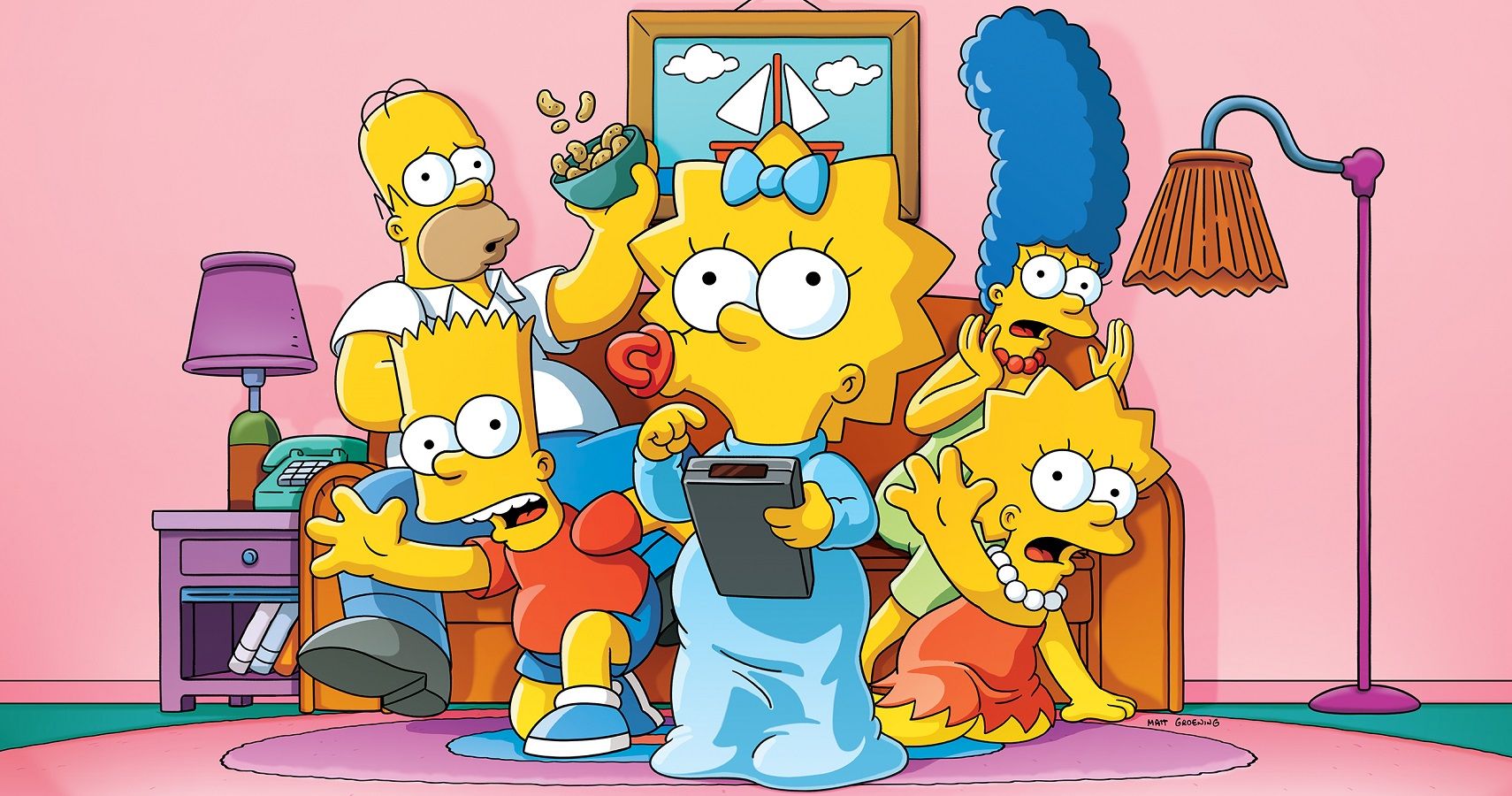
For fans of The Simpsons and mystery storytelling alike, these episodes represent the gold standard of animated television excellence. The storyline’s enduring popularity proves that great writing, compelling characters, and innovative storytelling transcend medium and genre boundaries to create truly timeless entertainment.
Whether you’re revisiting this classic mystery or discovering it for the first time, the Mr. Burns shooting episodes offer rich rewards for viewers willing to appreciate the craft, creativity, and cultural significance of this remarkable achievement in television history. The question “Who shot Mr. Burns?” may be answered, but the episodes’ impact on popular culture continues to resonate with new generations of fans discovering Springfield’s greatest mystery.

